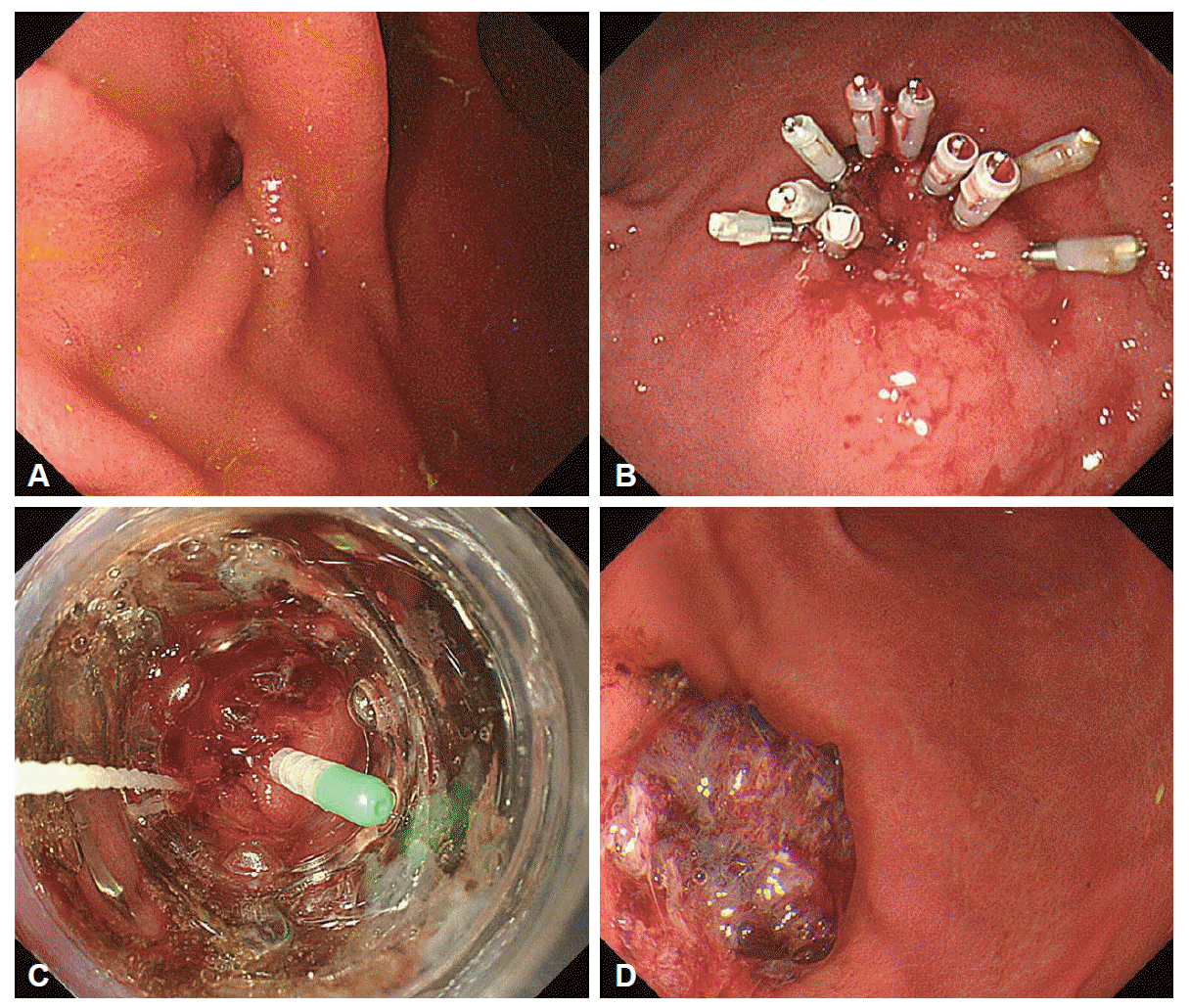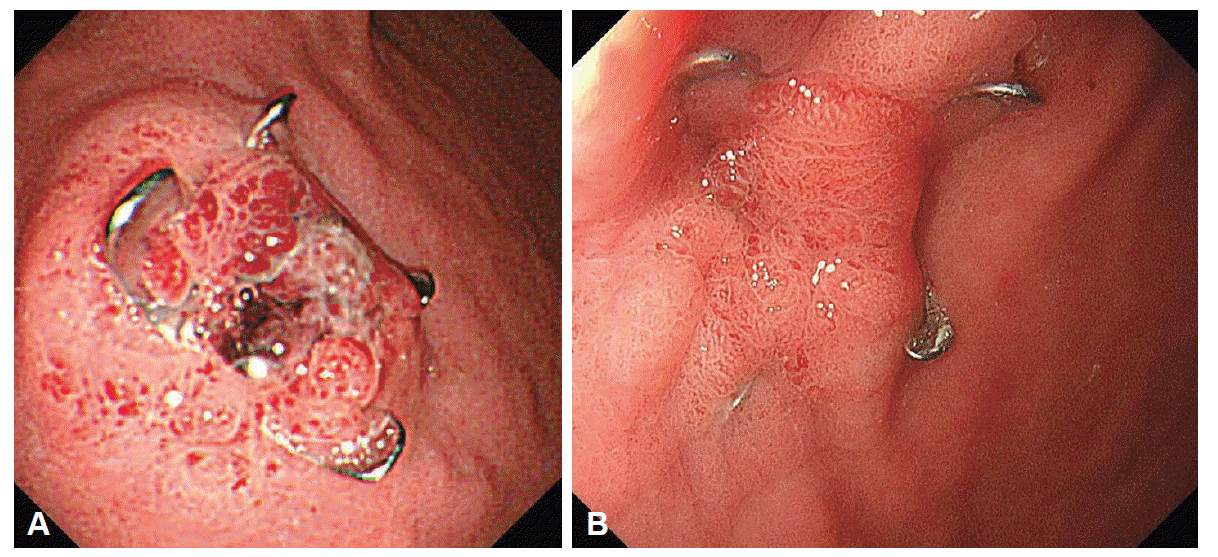Abstract
A 50-year-old woman had a percutaneous endoscopic gastrostomy (PEG) tube placed after surgery for pharyngeal cancer. After 21 months, the PEG tube was removed due to improvement of per-oral ingestion. She had taken prednisolone for 31 years for systemic lupus erythematosus. The post-PEG fistula did not close spontaneously. The cause of the fistula was slow wound healing and gastrostomy site inflammation due to long-term steroid therapy. We were able to close the fistula with an over-the-scope clipping (OTSC) system. This case suggests that OTSC is useful for closing persistent post-PEG fistulas in patients receiving long-term prednisolone therapy.
After percutaneous endoscopic gastrostomy (PEG) tube removal, the gastrostomy tract usually closes shortly without skin suture or surgical closure. However, a persistent post-PEG fistula may occur in adults [1], and various approaches to closing these fistulas have been reported, including silver nitrate ablation, argon plasma coagulation, fibrin glue, and endoclipping [2]. Here, we report the utility of over-the-scope clipping (OTSC) for the closure of a persistent post-PEG fistula in a patient receiving long-term steroid therapy.
A 50-year-old woman with pharyngeal cancer had a PEG tube placed after cancer surgery. She had taken prednisolone for 31 years for systemic lupus erythematosus, at a dose of 12 mg per day. After 21 months, the PEG tube was removed due to improvement of per-oral ingestion; however, the post-PEG fistula did not close spontaneously. Slight swelling and reddening of the skin surrounding the fistula suggested inflammation, but laboratory data suggested neither inflammation nor undernutrition.
The fistula continued to leak despite conservative therapy, antibiotics, proton pump inhibitor therapy, and drainage from a nasogastric tube. Esophagogastroduodenoscopy revealed a fistula 4 mm in diameter (Fig. 1A). We tried to close the fistula with endoclips, but the endoclips slipped on the mucosa due to induration of the submucosal tissue, and the procedure failed (Fig. 1B). After obtaining informed consent from the patient, we used an OTSC system (GIF-H260, Olympus, Tokyo, Japan; OTSC type-t 9 mm, Ovesco, Tübingen, Germany) 31 days after tube removal. Following the removal of the endoclips, the mucosa around the fistula was aspirated into the distal transparent cap and the OTSC was released (Fig. 1C, D). There was no subsequent leakage of gastric contents from the fistula, and the patient was discharged 14 days after closure (Fig. 2).
The presumed risk factors for persistent post-PEG fistula include stomal infection, undernutrition, and delayed gastric emptying. In the present case, the lack of fistula closure may have been caused by interrupted wound healing and gastrostomy site infection due to long-term steroid therapy. We could not close the fistula with conservative therapy under the conditions produced by long-term steroid therapy, suggesting that mechanical sutures may be necessary for fistula closure in patients receiving steroids.
We first chose endoclips to close the fistula, but this was unsuccessful. At more than 4 weeks after PEG tube removal, the stomal tissue hardens due to fibrosis [3], and thus stomal induration due to fibrosis may have been the cause of our failure to close the fistula using endoclips. However, we were able to close the post-PEG fistula with OTSC. This method has previously been used for post-PEG fistula closure [4-10], but not always successfully, with failure in 3 of 11 reported cases (27.3%) (Table 1). Albert et al. [3] suggested that tissue induration induced by fibrosis reduces the closure success rate for chronic fistulas such as post-PEG fistulas when using OTSC. However, we were able to close the fistula by aspirating the mucosa into the cap and grasping the mucosa firmly with the OTSC system. This approach may be important for overcoming tissue induration. The successful outcome in the current case suggests that OTSC is useful for post-PEG fistula closure in patients receiving steroid therapy and with evidence of stomal stiffening.
REFERENCES
1. Eskaros S, Ghevariya V, Krishnaiah M, Asarian A, Anand S. Percutaneous endoscopic suturing: an effective treatment for gastrocutaneous fistula. Gastrointest Endosc. 2009; 70:768–771.

2. Deen OJ, Parisian KR, Harris C 3rd, Kirby DF. A novel procedure for gastrocutaneous fistula closure. J Clin Gastroenterol. 2013; 47:608–611.

3. Albert JG, Friedrich-Rust M, Woeste G, et al. Benefit of a clipping device in use in intestinal bleeding and intestinal leakage. Gastrointest Endosc. 2011; 74:389–397.

4. Turner JK, Hurley JJ, Ketchell I, Dolwani S. Over-the-scope clip to close a fistula after removing a percutaneous endoscopic gastrostomy tube. Endoscopy. 2010; 42 Suppl 2:E197–E198.

5. Kirschniak A, Subotova N, Zieker D, Königsrainer A, Kratt T. The Over-The-Scope Clip (OTSC) for the treatment of gastrointestinal bleeding, perforations, and fistulas. Surg Endosc. 2011; 25:2901–2905.

6. Monkemuller K, Peter S, Toshniwal J, et al. Multipurpose use of the ‘bear claw’ (over-the-scope-clip system) to treat endoluminal gastrointestinal disorders. Dig Endosc. 2014; 26:350–357.
7. von Renteln D, Denzer UW, Schachschal G, Anders M, Groth S, Rösch T. Endoscopic closure of GI fistulae by using an over-the-scope clip (with videos). Gastrointest Endosc. 2010; 72:1289–1296.

8. Sandmann M, Heike M, Faehndrich M. Application of the OTSC system for the closure of fistulas, anastomosal leakages and perforations within the gastrointestinal tract. Z Gastroenterol. 2011; 49:981–985.

9. Surace M, Mercky P, Demarquay JF, et al. Endoscopic management of GI fistulae with the over-the-scope clip system (with video). Gastrointest Endosc. 2011; 74:1416–1419.

10. Kobara H, Mori H, Fujihara S, et al. Clinical experience with a novel full-thickness clipping device: over-the-scope-clip system. Gastroenterol Endosc. 2013; 55:1854–1863.
Fig. 1.
Endoscopic findings. (A) Endoscopic view showing a fistula of 4 mm in diameter. (B) An attempt to close the fistula with endoclips failed. (C) The fistula was identified endoscopically by tube insertion through the fistula. (D) The fistula was successfully closed with over-the-scope clipping.

Fig. 2.
Endoscopic findings. (A) The over-the-scope clipping (OTSC) clip 2 days after the procedure. (B) The OTSC clip was covered with regenerating mucosa 13 days after the procedure.

Table 1.
Reported Cases of Over-the-Scope Clipping for Post-Percutaneous Endoscopic Gastrostomy Fistula
| Study | No. of patients | Time until OTSC, moa) | Size of fistula, mm | Efficacy | Complication |
|---|---|---|---|---|---|
| Turner et al. (2010) [4] | 1 | 4 | Unknown | Primary | No |
| von Renteln et al. (2010) [7] | 1 | 2 | Unknown | Secondary | No |
| Albert et al. (2011) [3] | 1 | >1 | Unknown | Failure | No |
| Sandmann et al. (2011) [8] | 1 | Unknown | Unknown | Primary | No |
| Kirschniak et al. (2011) [5] | 4 | Unknown | Unknown | Two failures | No |
| Surace et al. (2011) [9] | 1 | 36 | Unknown | Primary | No |
| Kobara et al. (2013) [10] | 1 | Unknown | 10 | Primary | No |
| Monkemuller et al. (2014) [6] | 1 | Unknown | 12 | Primary | No |




 PDF
PDF Citation
Citation Print
Print


 XML Download
XML Download